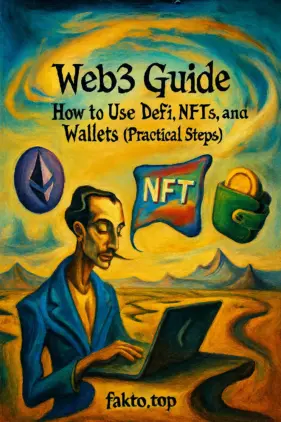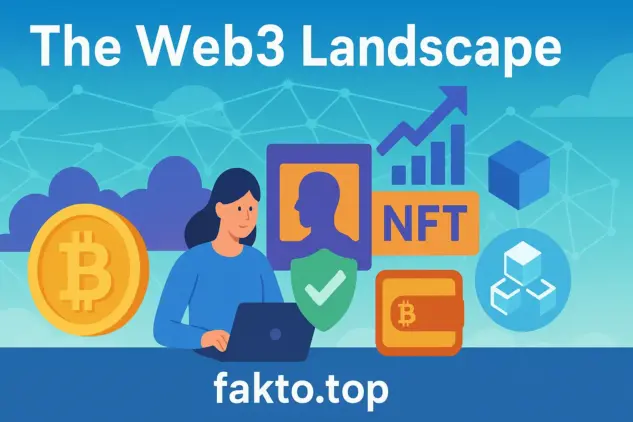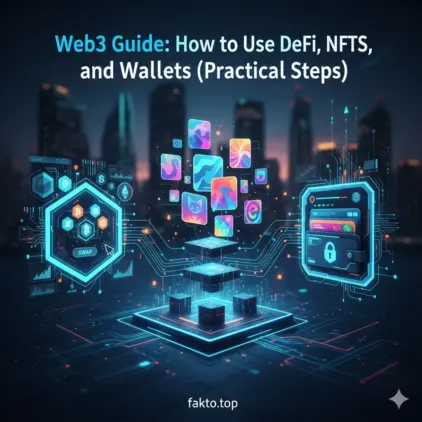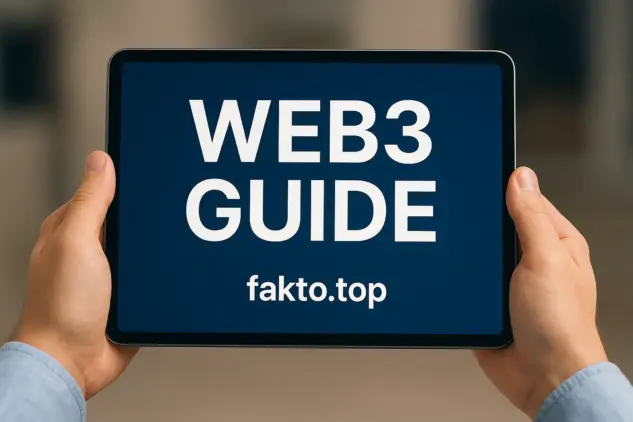Web3 Guide: How to Use DeFi, NFTs, and Wallets (Practical Steps)
The Web3 Landscape: A Practical Guide for Real People
If you spend time online, you already know the trade: you get free apps, and big platforms take your data. Every search, every photo, every chat message becomes someone else’s property. That’s Web2. It’s convenient but built on a system where users create value and corporations capture it. Web3 flips that idea on its head. Instead of giving away your data for free, you get ownership, control, and the ability to participate in the value you create.

This guide isn’t another technical lecture about cryptography or complicated blockchain theory. You already know the basics: Bitcoin exists, Ethereum powers smart contracts, and people trade crypto on exchanges. That’s great—but now it’s time to go beyond the theory. Web3 is not just something to invest in. It’s something you can use. Financial products without banks. Digital assets that belong to you, not to a platform. Communities that make decisions together instead of following corporate rules. That’s the practical side of Web3, and that’s what this guide is all about.
So let’s keep it simple: Web3 is the next version of the internet where users own their identity, their data, and their digital assets. No middleman, no CEO pressing a “ban” button, no silent data collection that ends up sold to advertisers. Instead of trusting a company, users trust open code and transparent rules stored on the blockchain.
Why should anyone care? Because Web3 solves real pain points:
- You own your data: No one can delete your account or steal your digital creations.
- You control your money: Send and receive funds anywhere in the world without a bank.
- You capture value: If you create something—art, content, a game item—you can sell it, trade it, and prove it’s yours.
- You participate: Communities become owners, not customers.
Most people think Web3 is “too technical” or “only for programmers.” The truth is different. Today, there are beginner-friendly wallets, marketplaces, apps, and social platforms that anyone can learn to use. You don’t need to code; you just need to know where to start.
Here’s what you’ll learn in this practical guide:
- How Web3 works in real life—not theory, but real tools you can use today.
- Where to start with DeFi: lending, borrowing, and earning yield without a bank.
- How NFTs provide true digital ownership—and how to buy or mint one safely.
- What DAOs are and how to join a community that votes on real decisions.
- How Web3 gaming and social platforms reward players and creators directly.
- Which wallets and blockchains are best for beginners, DeFi users, or NFT collectors.
The goal is simple: take someone with basic crypto knowledge and help them actually use Web3. Not tomorrow—today.
By the time you finish all six parts of this guide, you’ll know how to set up a wallet, try real decentralized apps, keep your crypto safe, and choose the best tools for your goals. You’ll also see how Web3 compares with Web2 when it comes to privacy, control, monetization, and innovation. No hype, no promises of overnight riches—just practical knowledge you can apply immediately.
Ready to explore the new internet where users finally have a seat at the table? Good. Let’s start with the most active corner of Web3: decentralized finance.
Decentralized Finance (DeFi): Where Anyone Can Be Their Own Bank
In traditional finance, you need permission for everything. Banks decide who gets loans, what fees you pay, and sometimes even when you can access your own money. DeFi takes that entire system and rebuilds it without gatekeepers. No bank clerks, no hidden fees, no waiting for approval. Anyone with a crypto wallet can lend, borrow, earn yield, or trade directly through decentralized applications—also known as dApps.
So why do people actually use DeFi? For many, it’s about inclusion and control. A person in a country with strict banking rules or unstable currency can access global markets as easily as someone in New York or London. Others simply want better returns than what banks offer. Instead of a savings account paying less than 1% interest, DeFi platforms allow users to earn yield directly from liquidity pools or lending protocols. It feels like a futuristic version of finance, but it already works today.

Let’s break down the core idea: smart contracts. On decentralized networks like Ethereum, code replaces the middleman. A smart contract holds funds, calculates interest, and enforces rules automatically. You don’t need to trust a company—you just trust code that everyone can audit. If terms are transparent and visible to the public, there’s no room for manipulation behind closed doors.
What can a beginner do in DeFi?
- Lend crypto and earn interest: Platforms like Aave or Compound allow you to deposit assets. Other users borrow them, and you earn yield—similar to a bank, but without the bank.
- Borrow against your crypto: Instead of selling your tokens when you need cash, you can borrow stablecoins and keep your original assets.
- Provide liquidity: Decentralized exchanges such as Uniswap let you supply tokens to liquidity pools and earn a share of trading fees.
- Trade directly on-chain: No registration, no KYC, no waiting—just connect your wallet and swap assets instantly.
What does it look like in practice? Here’s a simple example of lending:
- Install a wallet such as MetaMask or Trust Wallet.
- Buy or transfer a token like USDC or ETH into your wallet.
- Visit a DeFi platform like Aave.
- Connect your wallet with one click.
- Choose an asset and deposit it.
- Your balance starts earning yield automatically.
No paperwork, no bank approval, no personal data required. The process usually takes just a couple of minutes.

Of course, DeFi isn’t magic. There are risks: smart contract bugs, volatile assets, and market downturns. That’s why beginners should start slow and follow a simple rule—never invest money you can’t afford to lose. Begin with well-known platforms and learn how fees, liquidity, and collateral work before exploring advanced strategies like yield farming or leverage.
Choosing the right wallet also matters. For basic DeFi usage, hot wallets such as MetaMask or Rabby offer easy browser integration and support for most dApps. More experienced users often combine them with hardware wallets like Ledger for stronger security. A hardware wallet keeps your private keys offline, reducing the risk of hacks.
Security tips for new users:
- Never share your seed phrase with anyone.
- Double-check website URLs—phishing clones are common.
- Start with small amounts to learn how gas fees and transactions work.
- Avoid unknown tokens promising “huge guaranteed profit.” Nothing in DeFi is guaranteed.
The beauty of DeFi is that you keep control of your funds at all times. Nobody can freeze your account or stop a transaction. If you want to transfer money, withdraw, or switch platforms, everything is instant and permissionless. For a world used to waiting days for international transfers or begging banks for access, this feels like financial freedom in its purest form.
That covers finance. But Web3 is about more than money. Next, let’s talk about digital ownership and a new kind of asset: NFTs.
NFTs and Digital Ownership: Your Assets, Your Rules
NFTs are often misunderstood. Many people think they are just overpriced JPEGs or hype-driven collectibles. But the real idea behind non-fungible tokens is simple: ownership. If you own an NFT, it’s recorded on the blockchain. No company can delete it, take it away, or change its history. It’s yours in the same way you own a physical object.
Why does this matter? Because until Web3, ownership of digital assets barely existed. If you bought a game skin, a movie, or a digital item, you didn’t truly own it. You just rented access. If a platform shut down or banned your account, everything disappeared. NFTs fix that. They turn digital items into property you control with your wallet, not a username on someone else’s server.
NFTs have many real use cases:
- Art and collectibles: Artists can sell digital works directly to collectors without galleries or middlemen.
- Gaming items: Weapons, skins, land, and characters become tradable assets instead of locked items.
- Domain names: Web3 domains like .eth or .crypto work as wallet addresses and portable identities.
- Membership passes: Owning an NFT can give access to events, groups, or online communities.
The reason people care about NFTs is not only ownership, but also portability. If you have a Web3 wallet, your assets travel with you from one dApp to another. No company controls them. You could trade an NFT today, hold it for years, or simply prove that you created it.
So how does someone actually buy or mint an NFT?
- Set up a crypto wallet such as MetaMask or Trust Wallet.
- Buy some ETH or another supported token.
- Connect to a marketplace like OpenSea, Blur, Magic Eden, or Rarible.
- Browse items, check the creator and collection details, and make sure the project is legitimate.
- Click “Buy” or “Mint,” confirm the transaction, and the NFT appears directly in your wallet.
That’s it. No account creation, no password, no platform holding your assets hostage. The blockchain becomes the record of ownership, and your wallet is the key that controls it.
But just like with DeFi, beginners must be careful. If something sounds too good to be true, it usually is. Scammers often copy collections, impersonate artists, or sell fake mint links. The safest approach is to stick with known marketplaces and verify collections with large communities or real creators.

Popular beginner-friendly marketplaces:
- OpenSea — the largest NFT marketplace with broad support.
- Blur — focused on active traders and fast tools.
- Magic Eden — strong for gaming and Solana-based projects.
- NFT domain platforms like ENS Domains and Unstoppable Domains.
Some people worry: “What stops someone from copying the image?” Nothing. They can copy the file, but not the ownership. The NFT doesn’t prove who saved the picture—it proves who owns the original asset linked on the blockchain. You can download the Mona Lisa, but that doesn’t make you the owner of the painting.
Just like a rare collectible in the physical world, the value of an NFT depends on demand, reputation, and uniqueness. Some NFTs are cheap or free. Others become valuable because they carry utility, membership access, or brand recognition. Many Web3 communities use NFTs as digital tickets to private chats, early product access, or governance events.
For beginners, the best path is to experiment with small purchases. Try a cheap collectible or a simple ENS-style domain. Learn how transactions feel, how gas fees work, and how to view items in your wallet. Once you understand the basics, everything else becomes easier.
With NFTs, ownership goes beyond files. You can create, collect, trade, or build communities around them. And if you ever buy something you regret, you can sell it or transfer it freely—no platform permission required.
Next, let’s explore a new way of coordinating people: DAOs, where communities make decisions together instead of following a corporate boss.
DAOs: Communities That Work Like Digital Cooperatives
In Web2, platforms are controlled from the top. A small group of founders or executives decides how the product works, who gets access, and how profits are distributed. Users can complain, but they can’t vote. Web3 introduces a different model: the decentralized autonomous organization, or DAO. It works like a digital cooperative where the community makes decisions openly, using tokens and transparent on-chain voting.
The idea is simple. Instead of trusting a CEO, you trust code and collective decision-making. Members hold tokens or NFTs that give them voting power. When a proposal is submitted — such as funding a project, spending the treasury, or changing rules — every voting member can participate. The results are recorded publicly on the blockchain, so there is no way to change votes or hide financial decisions.
Why do people join DAOs? For three main reasons:
- Real influence: You get a voice in how a project develops, not just a comment box.
- Shared ownership: Participants can earn tokens or rewards for contributing.
- Transparency: Everyone can see how the treasury is used and where funds go.
DAOs can be small, like a group of artists sharing revenue, or massive communities managing millions of dollars. Some build products, some fund research, and others run games or NFT collections. The structure works because smart contracts handle rules automatically. Once a proposal passes, the contract executes it — no human can interfere.

Joining a DAO is much easier than people think. Here’s how it usually works:
- Get a Web3 wallet like MetaMask.
- Buy a small amount of ETH or the token used by the DAO.
- Visit a platform such as Snapshot, Aragon, or Discord where proposals are posted.
- Connect your wallet and read current proposals.
- If you hold the required token, you can vote with one click.
Some DAOs use membership NFTs instead of tokens. Owning the NFT gives you access to community chats, voting rights, or profit distribution. It feels more like holding a digital membership card than buying a random coin.
For beginners, the safest strategy is to observe before voting. Watch how proposals are written, how funds are moved, and how members discuss decisions. Serious DAOs publish transparent budgets, reports, and goals. If everything happens in secret, that’s a warning sign.
Popular examples:
- Uniswap DAO: Governs one of the largest decentralized exchanges.
- Aave DAO: Controls upgrades and decisions for the Aave lending protocol.
- ENS DAO: Manages .eth domains and ecosystem development.
- Friends With Benefits: A social DAO with membership NFTs and community events.
These communities have thousands of members and control large treasuries. Every major change — product updates, grants, partnerships — must pass through the voting process. It’s messy, democratic, and sometimes slow, but users finally have a voice. Unlike Web2 platforms, a DAO can’t suddenly ban users or pivot the business without community approval.
However, DAOs are not perfect. Voting power often depends on token ownership, so users with large holdings have more influence. Some proposals receive low voter turnout because people don’t participate. And since everything is transparent, financial decisions can attract attention from bad actors. Still, many communities prefer this open structure to secret boardrooms and closed contracts.
If you want to try a DAO without spending money, look for communities that allow free participation through forums and Discord. Some DAOs reward contributors with tokens for writing articles, coding, designing graphics, or helping with moderation. Instead of paying to enter, you can earn your membership by adding value.
With DAOs, Web3 becomes more than technology—it becomes social. People coordinate, create, invest, and vote together. It’s a new model of digital governance where users move from “customers” to “co-owners.”
Now that we’ve covered finance, ownership, and governance, let’s explore something more fun: decentralized social platforms and GameFi, where players and creators finally get rewarded for their time.

Decentralized Social and Gaming: When Your Time and Content Actually Matter
Web2 social networks are simple: you create content, companies earn money. Your posts attract users, advertisers pay platforms, and you get… likes. It’s a one-sided deal. Web3 changes the relationship. Social platforms run on-chain, content is tied to your wallet identity, and you can actually earn from what you create. Instead of a platform owning your followers and data, you control your identity and move it anywhere.
In decentralized social networks, your profile is not stored on a private server. It lives in your wallet. If a platform shuts down or changes rules, you won’t lose your audience. You simply connect to another app that reads the same data. Imagine taking your followers, posts, and identity with you wherever you go — that’s the Web3 version of social media.
Creators also gain new monetization options. Instead of relying on ads or middlemen, users can sell content access, receive tips, or issue membership NFTs. Some platforms reward activity directly with tokens, turning engagement into actual ownership. It’s not about becoming a millionaire overnight — it’s about finally being part of the value you generate.
What does using a Web3 social app look like?
- Install a Web3 wallet like MetaMask.
- Create an on-chain profile using a platform such as Lens or Farcaster.
- Your posts, followers, and social graph connect to your wallet.
- You keep control, even if you switch apps or interfaces.
There’s no “sign in with email,” no shadow bans, no corporate data mining. Your identity is portable and user-owned. Some platforms reward activity with tokens, offer NFT-based subscriptions, or allow peer-to-peer tipping with stablecoins.
GameFi uses similar logic, but inside games. Instead of games locking your items to a single account, Web3 turns skins, characters, or land into tradable assets. If you earn something, it’s yours forever. You can sell it, trade it, or transfer it to another wallet. That’s a huge shift from the Web2 gaming model where billions of dollars are spent on items that players can never resell.
Play-to-earn models became popular because players could receive tokens or NFT rewards for completing tasks, battling other players, or building inside virtual worlds. Not every game succeeds, and many early projects struggled, but the idea is powerful: your time has value. If a game grows, early players benefit instead of corporations alone.
How does someone try GameFi without experience?
- Get a wallet and a small amount of crypto for gas fees.
- Choose a beginner-friendly game with low entry cost on networks like Polygon or BNB Chain.
- Log in using your wallet instead of creating a username and password.
- Play, earn rewards, and store items in your wallet — not on a company server.
Notable examples include virtual worlds, NFT card games, and strategy titles where assets are owned by players. Some users trade rare items on marketplaces, while others rent NFTs to new players in exchange for a percentage of earnings. In Web3 gaming, the marketplace becomes player-driven instead of controlled by a central company.
As always, newcomers should stay cautious. Free-to-play or low-cost games are safer than expensive ones. Avoid games promising unrealistic rewards or guaranteed income. Web3 can create opportunities, but every project has risks. Start small, learn the mechanics, and explore communities to see if a game has long-term trust.
Decentralized social platforms and GameFi show a new internet where time, creativity, and community matter. Users are participants, not products. After exploring use cases, it’s time to talk about the tools that make everything possible — wallets and blockchains.
Web3 Infrastructure: Wallets, Chains, and the Final Comparison
To use Web3, you need only one essential tool: a wallet. It works like a digital passport that stores your assets, identity, and login access to decentralized apps. When you connect your wallet to a marketplace, lending platform, or game, it acts as your account. There’s no email, no password, and no platform holding your funds.

Setting up a wallet is simple:
- Download MetaMask, Trust Wallet, Coinbase Wallet, or another reputable option.
- Create a new wallet and write down your seed phrase — 12 or 24 secret words.
- Store the seed phrase offline. Never type it in chats or screenshots.
- Buy or transfer crypto such as ETH, MATIC, or SOL to start using dApps.
Your wallet becomes your identity and your vault. If you lose the seed phrase, no one can recover it — not even the wallet provider. That’s the price of full control: you are your own bank.
Web3 Wallets Comparison: Features, Security, Use Cases
| Wallet | Type | Primary Chain Support | Best For |
|---|---|---|---|
| MetaMask | Hot Wallet | Ethereum & Layer 2 | DeFi, NFTs, Beginners |
| Ledger | Cold Hardware Wallet | Multi-Chain | Long-term storage, High-security users |
| Trust Wallet | Hot Mobile Wallet | Multi-Chain | Mobile-first beginners, NFT minting on multiple chains |
Hot wallets connect to the internet and are easy to use. Cold wallets stay offline, making them safer for storing valuable assets. Many users combine both: a hot wallet for daily transactions and a hardware wallet for long-term holding.
Choosing the right blockchain also matters. Layer 1 networks like Ethereum, Solana, and Avalanche are main blockchains with their own security and validators. Layer 2 networks like Polygon or Arbitrum build on top of Ethereum to make transactions cheaper and faster. If you want high-value NFTs or maximum security, Ethereum is a strong choice. If you prefer low fees and fast apps, Polygon or Arbitrum may feel better.
Now let’s finish with the big question: how is Web3 different from the internet we use today?
Web2 vs Web3: Who Controls the Value?
| Category | Web2 | Web3 |
|---|---|---|
| Ownership | Platforms own data and accounts | Users own identity and assets via wallets |
| Monetization | Companies profit, users get content exposure | Users earn directly through tokens, NFTs, rewards |
| Transparency | Closed systems and private servers | Open smart contracts and public ledgers |
| Control | Accounts can be banned or censored | No central authority — true user control |
| Innovation | Limited to platform terms | Anyone can build on open protocols |
Common Questions
Is Web3 safe? It can be, if you protect your wallet, avoid suspicious links, and use trusted apps.
Can I lose money? Yes — markets are risky and mistakes are permanent. Start small and learn gradually.
Is it too late to join? Absolutely not. Most people still don’t use Web3 daily. Early adopters are learning, not racing.
Top Beginner Tips
- Start with small transactions to learn how wallets and fees work.
- Never share your seed phrase — not even with support staff.
- Use well-known platforms like OpenSea, Aave, or Uniswap.
- Try testnets for free practice before using real funds.
- Move long-term assets to a hardware wallet.
Web3 is not a buzzword. It’s a new internet where users take control — of money, identity, and creativity. You don’t need to understand every piece of technology to start. All you need is a wallet and curiosity.
If you’re ready to try Web3, take the first step now: install a wallet, explore a dApp, and experience what ownership feels like.
Disclaimer
Nothing in this article is financial advice. The examples, platforms, wallets and services are listed for educational purposes only. Cryptocurrency is volatile, tokens may lose value, and every user is responsible for their own decisions. Always double-check websites, never share private keys and start with small amounts you are ready to lose.
